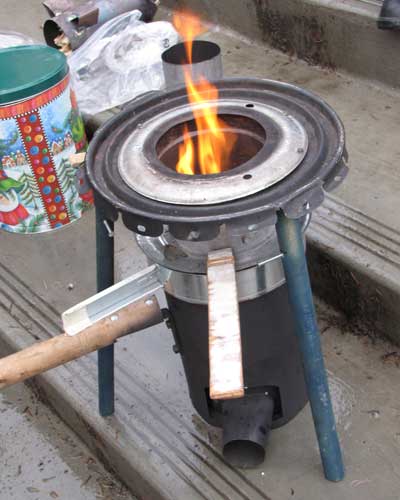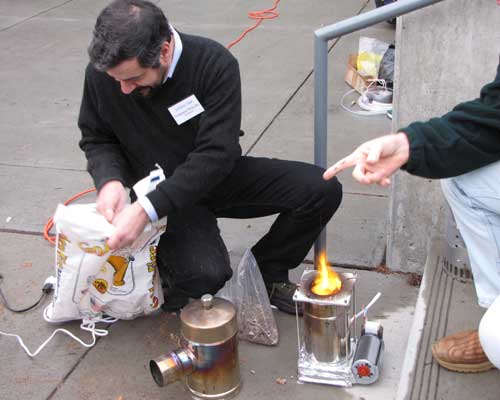January 23 through 25, 2009, about 100 “stovers” gathered in Kirkland, Wash., for the annual ETHOS (Engineers in Technical and Humanitarian Opportunities of Service) conference devoted to meeting household energy needs in the developing world. Improved stove technology was only part of a program that included discussion of standards and testing, distribution and manufacturing, and the intricacies of carbon credit financing. The highlight of the conference occurred at the ceremonial “lighting of the stoves” on the concrete steps outside the conference hall under a light flurry of snow late on Sunday afternoon.
A variety of innovative designs were on display, but only two of the stoves were able to operate in a pyrolysis mode to produce charcoal. Paul Anderson, an independent stover who works with the Biomass Energy Foundation, demonstrated a TLUD (top-lit updraft gasifier) stove using natural draft that leaves a charcoal residue after cooking. The char can be saved by dumping it into a covered bucket or pot to stop combustion. Anderson has two versions, what he calls the “refugee” stove made of tin cans, and the “artisan” version that will be manufactured in India. Plans for constructing the stoves will be freely available soon on the bioenergy listserve.

|
PHOTO BY KELPIE WILSON/INTERNATIONAL
BIOCHAR INITIATIVE
|
Paul Anderson's "artisan" top-lit updraft (TLUD) gasifer stove
produces charcoal at the end of a cooking session that can be
saved in a covered metal bucket or ceramic pot. |
Biochar advocates at the conference were very intrigued with the Lucia stove invented by entrepreneur Nat Mulcahy of WorldStove. Mulcahy is an industrial designer who has thrown himself into the project of bringing a sophisticated, high performance biomass stove to mass markets worldwide. Contrary to the approach of many stove designers who search for designs that can be easily manufactured in poor countries, Mulcahy wondered what could be accomplished using advanced manufacturing technology. He found that metal injection molding allowed him to make a burner with a swirl pattern resulting in highly efficient combustion and heat transfer. When used with a fan, the stove can be operated in a pyrolysis mode that produces charcoal. You can see his pyrolysis demonstration at the WorldStove YouTube channel.

|
PHOTO BY KELPIE WILSON/INTERNATIONAL BIOCHAR INITIATIVE
|
Nat Mulcahy prepares to add fuel to his Lucia stove. The copper pot can be set on
top of the stove to function as a space heater. |
Mulcahy’s burner is made out of 28 recycled aluminum cans. An aluminum inlet plate and a cast-iron forge plate complete the list of special parts; the rest of the stove can be put together from sheet metal, common fasteners and fans recycled from computers. The parts can be shipped flat and assembled locally. WorldStove plans to start production at a factory in northern Italy in March. The stove has been certified in Europe as producing less than 66 ppm carbon monoxide, and WorldStove is pursuing licenses to manufacture a model that will work as a fireplace insert, along with another model that Mulcahy says will triple the heat output and halve the emissions of a standard pellet stove. He also announced that Finland wants to subsidize 1.5 million of his stoves for saunas with the objective of producing biochar.
The new Biolite stove by industrial designers Jonathan Cedar and Alec Drummond does not make char, but is interesting nonetheless. A lightweight backpacking stove, its key innovation is to incorporate a bismuth-telluride thermoelectric generator (TEG) to operate a forced-air draft fan for this gasifier stove. The TEG is a nice innovation that could be applied to biochar producing stoves that use fans, eliminating the need for any external power supply.

|
PHOTO BY KELPIE WILSON/INTERNATIONAL BIOCHAR INITIATIVE
|
Prototypes of the Biolite backpacking stove designed by Jonathan Cedar and
Alec Drummond. The fan is powered by an integrated thermoelectric generator. |
Aside from exciting new technology, the Ethos conference offered many sessions concerned with the problems of stove dissemination. More than 1.5 billion people still cook over open fires. Impacts to health, safety, forests, air and climate could be mitigated with better stoves, but lack of funding for stove programs is a huge barrier. Carbon credit financing can help.
Two groups shared information on ways to obtain carbon credit financing. Stuart Conway of Trees, Water and People explained the process his group went through to offer a direct voluntary offset for its programs. The Center for Entrepreneurship in International Health and Development (CEIHD) is available to help groups set up projects for carbon credits. Adding biochar production to a stove program can potentially increase the amount of carbon offset achievable, and internationally there is a growing interest in biochar-producing stoves.
In December 2008, at the climate meeting in Poland, The International Biochar Initiative (IBI) held a side event on stoves that was very well attended. See the description of this event on IBI’s Poznan page.
Standards and testing are topics that are also of concern to biochar producers. Aprovecho Research Center had a large presence at the conference and stove designers will want to take a look at all the resources they offer. Laboratory manager Nordica MacCarty had Aprovecho’s mobile emissions testing unit on display. The unit packs up into one large suitcase that can be taken into the field. MacCarty has done testing in India and is off to Africa next. Aprovecho also does emissions testing at their lab in Cottage Grove, Ore.
Many interesting discussions took place in the hallways and at meals. A small group of biochar enthusiasts discussed ideas for helping less fortunate people generate income by producing biochar. Other discussions heard at the Ethos Conference repeated this theme of providing income-generating solutions. The practical aspects of integrating appropriate technology into people’s lives emerged as perhaps the greatest challenge, whether in the developing or already developed worlds.